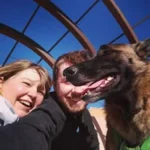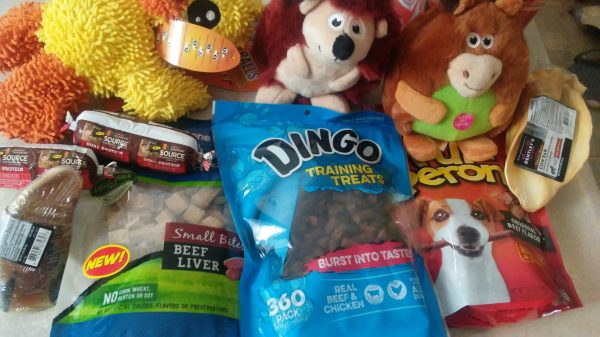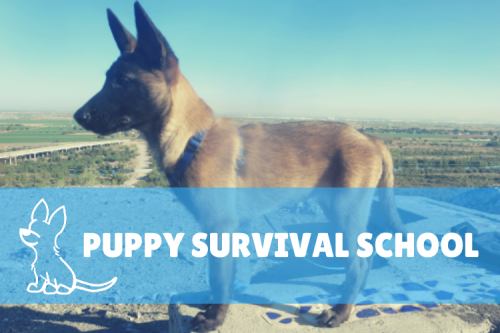Here’s a handy guide to all the stuff you’ll need when your puppy comes home. This list ties in to the 3 Lost Dogs training philosophy, and it’s all meant to help you raise a happy, well-behaved puppy who stays out of trouble as much as possible.
The list is divided into the Essential supplies and the Very Nice to Have supplies. Plus, we’ll talk about the stuff you can probably skip.
ESSENTIALS
A crate
In most cases, a dog crate makes training -especially potty training- much easier and faster. It gives you a place to keep the pup out of trouble when you can’t supervise, therefore preventing bad habits from developing.
Get a crate made out of wire or plastic. It should be big enough for the puppy to stand up, turn around, and stretch out in comfortably. Any bigger, and she could end up using one end as a bathroom, defeating the purpose.
Click here to learn more about dog crates.
Food
I recommend getting a dry food, and maybe a few cans of wet food for variety. Wet food is good for stuffing puzzle toys (see below).
The package should specify that it’s intended for puppies, not adult dogs. If your puppy is going to grow up to be a big dog, get a large-breed puppy food.
If you know what food the breeder/rescue has been feeding your pup, get the same kind, to avoid causing stomach upsets. You can gradually switch to a different food over 1-2 weeks, if you’d like.
Training treats
Each piece should be about the size of a pea. My favorite training treat? Real chicken, boiled and chopped into tiny pieces. It’s inexpensive, nutritious, and keeps a puppy’s attention reeeeaaaally well. Other good options include freeze-dried liver treats and small soft dog treats.
At least one puzzle toy

The puzzle toy is your new best friend! These are hollow dog toys that you stuff with food. I feed my puppies their meals out of these instead of bowls. It keeps them occupied and out of trouble, and gives them some much-needed brain work and exercise. For your puppy, I recommend getting one or two of the classic rubber kind, like a Kong.
Click here to learn more about puzzle toys.
High-Value Chews

Puppies looove to chew. Set them up for success by making sure they have lots of appropriate chew toys available, so they’ll be less likely to chew on your shoes or other valuables. Get things like bully sticks, pig ears, Himalayan dog chews, or Nylabones.
Avoid rawhide chews. These are difficult to digest and have a high risk of creating intestinal blockages that require surgery to fix.
Squeaky and plush toys

Get a variety of shapes and sizes. Your puppy will probably chew them up and shred them, and that’s okay! That’s what toys are for, when you’re a dog. My dogs immediately disembowel all the cute little stuffed animals I bring home for them. Just remember to supervise playtime, and pick up the destroyed toy bits to avoid choking hazards.
To keep the pup from getting bored, rotate through the toys: keep 2-3 available for a few days, then switch them out for a different set.
The right kind of pet mess cleaner
Welcome to the house training life! Even the most careful of us puppy parents will sometimes slip up on supervision, resulting in a puddle of puppy pee on the carpet.
Important – get the right kind of cleaner: the bottle must say “enzymatic” or “enzyme-based.” Other cleaners don’t completely remove the smell. If the puppy can still smell the mess, he’s likely to go again in the same spot. Get something like Nature’s Miracle.
Paper towels and/or rags
You’ll probably need a lot of ’em. #housetraininglife
Collar
An adjustable buckle collar made out of nylon or cotton. Check the fit: you should be able to fit two fingers underneath the collar when the dog is wearing it. More than two fingers, and it’s too loose and could end up snagging on something, choking the dog. Fewer than two fingers, it’s too tight.
Leash
Made of cotton, nylon, or leather. 4-6ft (about 1.5-2m) long.
Collar and leash pro tip: Don’t get them from Walmart. The clasps on every single collar and leash I ever got from a Walmart have come loose when the dog was wearing it. Walmart is a good place to get a lot of decent pet supplies for cheap, but this is one category I would spend a bit more for.
Food and water bowls
Fresh water should be available to your pup at all times, and sometimes you’ll probably want to put your pup’s dinner in a bowl instead of a puzzle toy.
Dog nail clippers
Nail trims are the bane of many a dog’s existence, so it’s important to teach your puppy to be cool with them early on. This is a topic we cover in Puppy Survival School.
There are two styles, scissor clippers and guillotine clippers. Either is fine for puppies. For adult dogs, the scissors are best for large dogs, and guillotines are best for small-medium dogs.
Poop scooping supplies
Poop bags for adventures in the world (plastic grocery bags work just fine for this purpose), and some kind of poop scooper for your yard. I just use a rake and shovel.
VERY NICE TO HAVE
This is the stuff you don’t necessarily need if money is tight, but will make your life easier if you can swing it.
Exercise pen and/or baby gates

Raising my puppy River was the first time I’d used an exercise pen to train a puppy, and now that I have, I don’t know how I ever managed without one. They’re super convenient. Baby gates can be used to keep your puppy out of off-limits areas, or to create a small puppy-proofed area.
Money-saving tip: these gates are usually much cheaper in the baby supplies department than in the pet supplies department. Walmart usually has basic $10 gates in their baby department.
Training treat pouch
While these sometimes border far too dangerously close to being a fanny pack for my liking, they make dog training much easier. All the cool dog trainers are wearing them. Here’s the basic style, and here’s my favorite version.
Long training leash
Like this. About 20ft (6m) long. Useful for teaching puppies important skills like coming when called.
Harness
It’s best to attach a leash to a harness instead of a collar, to reduce strain on your puppy’s delicate lil’ neck. And my personal favorite training approach is to put the leash on a dog’s harness when they’re allowed to run all over and pull and explore, and put the leash on their collar to signal that it’s time to practice nicer, non-pulling leash manners.
Bitter Apple spray
It tastes gross, so you spray it on objects you don’t want the puppy to chew on, like the corners of furniture, or your baseboards. Many other “deterrent sprays” don’t really work, so I’d go with the Bitter Apple brand, if you can find it.
YOU CAN SKIP
Clickers
Don’t get me wrong, I love clicker training, and my house is overflowing with clickers. But for new puppy owners, they can be overkill, and a little overwhelming. Instead, you can stick with a marker word, like “yes!” or “good!” Click here to learn how to train your puppy with a marker word.
Fancy crate bedding or dog beds
Your puppy is likely to chew up or pee on their bedding, so I wouldn’t bother spending money on bedding until the pup is older and slightly less destructive. You can use old blankets or towels in their crate for now. If you don’t have any lying around, you can get some cheap ones from the human bedding/towel department, or a thrift shop.
Retractable leashes
These can be pretty dangerous to both dogs and people. I once got my leg sliced up real bad from one of these suckers. They also make it difficult to properly handle your puppy while training.




